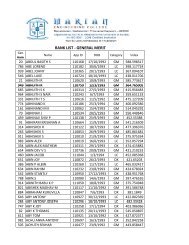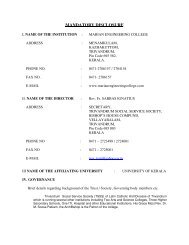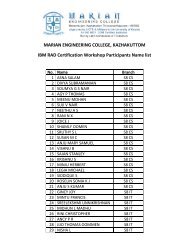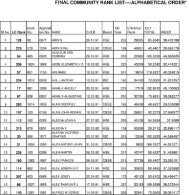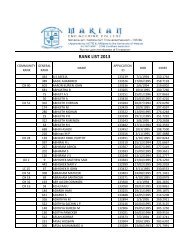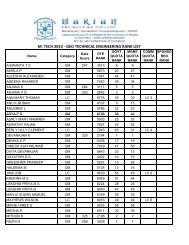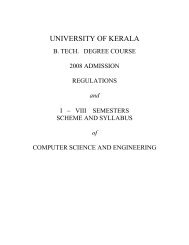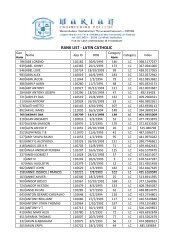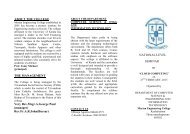UNIVERSITY OF KERALA - College of Engineering, Trivandrum
UNIVERSITY OF KERALA - College of Engineering, Trivandrum
UNIVERSITY OF KERALA - College of Engineering, Trivandrum
Create successful ePaper yourself
Turn your PDF publications into a flip-book with our unique Google optimized e-Paper software.
08.806.7 Elective IV GROUND WATER ENGINEERING<br />
L T P/D Cr<br />
3 0 0 3<br />
Module I<br />
Vertical distribution <strong>of</strong> ground water. Types <strong>of</strong> geologic formations-properties <strong>of</strong> aquifer related to storage and<br />
transmissivity <strong>of</strong> water. Steady unidirectional flow-steady flow in a homogeneous aquifer-aquifer with recharge-<br />
Flow into infiltration galleries. Importance <strong>of</strong> groundwater modeling. Governing equations <strong>of</strong> ground water flow<br />
and boundary conditions (basic ideas only). Finite Difference discretization, Solution <strong>of</strong> partial differential<br />
equation <strong>of</strong> ground water flow for 1D steady ground water flow in homogeneous aquifers (confined and<br />
unconfined) using finite difference method (uniform mesh interval only).<br />
Module-II<br />
Partial differential equations governing unsteady ground water flow-unsteady radial flow towards well.<br />
Evaluation <strong>of</strong> aquifer parameters by Jacob’s, Theis and Chow’s method.<br />
Well flow near aquifer boundaries-Image well system. Method <strong>of</strong> images- Wells-Types.<br />
Method <strong>of</strong> constructing shallow wells- Method <strong>of</strong> constructing shallow wells -cable tool method, rotary method<br />
and reverse rotary method-well completion-design <strong>of</strong> gravel packed well-well development-different methods,<br />
well rehabilitation.<br />
Module III<br />
Surface investigation <strong>of</strong> ground water-different methods- electrical resistivity method, seismic refraction<br />
method-determination <strong>of</strong> aquifer thickness <strong>of</strong> horizontal aquifers. Quality <strong>of</strong> ground water- Graphical<br />
representations. Pollution <strong>of</strong> ground water-sources, distribution and evaluation <strong>of</strong> ground water pollution (Brief<br />
description only). Sea water intrusion-Ghyben- Herzberg equation-seawater fresh water interface-upconingpreventive<br />
measures. Artificial recharge <strong>of</strong> groundwater-different techniques.<br />
References:<br />
1. D.K Todd, “Ground Water Hydrology”, Wiley International Ed; Toppan &Company Ltd, Tokyo, 1995.<br />
2. “Ground Water Manual’’, A Water Resources Technical Publication..<br />
3. Karanth , “ Ground Water Assessment, Development and Management’’, Tata McGraw Hill<br />
publishing company Ltd.<br />
4. S.P. Garg , “Ground Water and tube wells’’, Oxford &IBH Publishing Company.<br />
5. Herman Bouwer, “Ground Water Hydrology’’, Mc Graw Hill Kogakusha Ltd.<br />
6. H.M Raghunath , “ Ground Water Hydrology’’, Wiley Eastern Limited.<br />
7. Freeze and Cherry, “Ground Water” Prentice Hall<br />
8. Rastogi, A K. “Numerical groundwater hydrology”, Penram International Publishers, Mumbai<br />
Question Paper: Duration: 3 hours<br />
The question paper consists <strong>of</strong> Part A and Part B.<br />
Part A is for 40 marks. There will be 8 compulsory short answer questions <strong>of</strong> 5 marks each covering entire<br />
syllabus.<br />
Part B is for 60 marks. There will be two questions from each module. The candidate has to answer one<br />
question <strong>of</strong> 20 marks from each module.<br />
Note: No charts, tables, codes are permitted in the Examination hall .If necessary the same shall be given along<br />
with the question paper by the question paper setter.<br />
101



